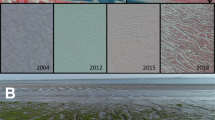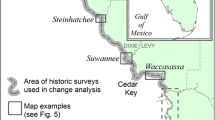Abstract
Tidal marshes are important ecological systems that are responding to sea level rise-driven changes in tidal regimes. Human development along the coastline creates barriers to marsh migration, moderating tidal marsh distributions. This study shows that in the Chesapeake Bay, USA an estuarine system with geographic and development variability, overall estuarine tidal marshes are projected to decline by approximately half over the next century. Tidal freshwater and oligohaline habitats, which are found in the upper reaches of the estuary and are typically backed by high elevation shorelines are particularly vulnerable. Due to their geological setting, losses of large extents of tidal freshwater habitat seem inevitable under sea level rise. However, in the meso/poly/euhaline zones that (in passive margin estuaries) are typically low relief areas, tidal marshes are capable of undergoing expansion. These areas should be prime management targets to maximize future tidal marsh extent. Redirecting new development to areas above 3 m in elevation and actively removing impervious surfaces as they become tidally inundated results in the maximum sustainability of natural coastal habitats. Under increasing sea levels and flooding, the future of tidal marshes will rely heavily on the policy decisions made, and the balance of human and natural landscapes in the consideration of future development.







Similar content being viewed by others
References
Arheimer B, Torstensson G, Wittgren HB (2004) Landscape planning to reduce coastal eutrophication: agricultural practices and constructed wetlands. Landscape and Urban Planning 67(1–4):205–215
Bierwagen BG, Theobald DM, Pyke CR, Choate A, Groth P, Thomas JV, Morefield P (2010) National housing and impervious surface scenarios for integrated climate impact assessments. Proceedings of the National Academy of Sciences 107(49):20887–20892
Bilkovic DM, Mitchell MM (2017) Designing living shoreline salt marsh ecosystems to promote coastal resilience. In Living shorelines: the science and Management of Nature-based Coastal Protection. (Eds: Bilkovic DM, Mitchell M, Toft J, La Peyre, M) Taylor & Francis Group and CRC press; CRC press marine science series
Boon JD (2012) Evidence of sea-level acceleration at US and Canadian tide stations, Atlantic Coast, North America. Journal of Coastal Research 28(6):1437–1445
Boon JD, Mitchell M (2015) Nonlinear change in sea-level observed at north American tide stations. Journal of Coastal Research 31(6):1295–1305
Boon JD, Mitchell M, Loftis JD, Malmquist DM (2018) Anthropocene Sea level change: a history of recent trends observed in the U.S. east, gulf, and west coast regions. Special report in applied marine science and ocean engineering (SRAMSOE) no. 467. Virginia Institute of Marine Science, College of William and Mary. https://doi.org/10.21220/V5T17T
Bromberg KD, Bertness MD (2005) Reconstructing New England salt marsh losses using historical maps. Estuaries and Coasts 28(6):823–832
Byrne RJ, Anderson GL (1978) Shoreline erosion in tidewater Virginia. Special report in applied marine science and ocean engineering no. 111, Virginia Institute of Marine Science, Gloucester Pt, VA, 102p
CCRM [Center for Coastal Resources Management] Digital Tidal Marsh Inventory Series (2017) Comprehensive coastal inventory program, Virginia Institute of Marine Science, College of William and Mary, Gloucester Point, Virginia, 23062
Chmura GL (2013) What do we need to assess the sustainability of the tidal salt marsh carbon sink? Ocean & Coastal Management 83:25–31
Church JA, White NJ (2011) Sea-level rise from the late 19th to the early 21st century. Surveys in Geophysics 32(4–5):585–602
Coverdale TC, Brisson CP, Young EW, Yin SF, Donnelly JP, Bertness MD (2014) Indirect human impacts reverse centuries of carbon sequestration and salt marsh accretion. PLoS One 9(3):e93296
Doyle TW, Krauss KW, Conner WH, From AS (2010) Predicting the retreat and migration of tidal forests along the northern Gulf of Mexico under sea-level rise. Forest Ecology and Management 259(4):770–777
Drake BG (2014) Rising sea level, temperature, and precipitation impact plant and ecosystem responses to elevated CO2 on a Chesapeake Bay wetland: review of a 28-year study. Global Change Biology 20(11):3329–3343
Eggleston J, Pope J. (2013) Land subsidence and relative sea-level rise in the southern Chesapeake Bay region: U.S. Geological Survey Circular 1392, 30 p., https://doi.org/10.3133/cir1392
Ezer T (2013) Sea level rise, spatially uneven and temporally unsteady: why the US East Coast, the global tide gauge record, and the global altimeter data show different trends. Geophysical Research Letters 40(20):5439–5444
Ezer T, Atkinson LP (2014) Accelerated flooding along the US East Coast: on the impact of sea-level rise, tides, storms, the Gulf stream, and the North Atlantic oscillations. Earth's Future 2(8):362–382
Ezer T, Atkinson LP (2015) Sea level rise in Virginia – causes, effects and response. Virginia Journal of Science 66(3):355–369
Feagin, RA, Martinez, M., Mendoza-Gonzalez, G, Costanza, R (2010) Salt marsh zonal migration and ecosystem service change in response to global sea level rise: a case study from an urban region. Ecology and Society, 15(4) [online] URL: http://www.ecologyandsociety.org/vol15/iss4/art14/
Gellis AC, Banks WS, Langland MJ, Martucci SK (2004) Summary of suspended-sediment data for streams draining the Chesapeake Bay watershed, water years 1952–2002. US Geological Survey Scientific Investigations Report 5056:1–59
Gittman RK, Fodrie FJ, Popowich AM, Keller DA, Bruno JF, Currin CA, Peterson CH, Piehler MF (2015) Engineering away our natural defenses: an analysis of shoreline hardening in the US. Frontiers in Ecology and the Environment 13(6):301–307
Hartig EK, Gornitz V, Kolker A, Mushacke F, Fallon D (2002) Anthropogenic and climate-change impacts on salt marshes of Jamaica Bay, New York City. Wetlands 22(1):71–89
Hong B, Shen J (2012) Responses of estuarine salinity and transport processes to potential future sea-level rise in the Chesapeake Bay. Estuarine, Coastal and Shelf Science 104:33–45
Jin D, Hoagland P, Au DK, Qiu J (2015) Shoreline change, seawalls, and coastal property values. Ocean & Coastal Management 114:185–193
Kearney MS, Rogers AS, Townshend JRG, Rizzo E, Stutzer D, Stevenson JC, Sundborg K (2002) Landsat imagery shows decline of coastal marshes in Chesapeake and Delaware bays. Eos 83:173–178. https://doi.org/10.1029/2002EO000112
Kirwan ML, Walters DC, Reay WG, Carr JA (2016) Sea level driven marsh expansion in a coupled model of marsh erosion and migration. Geophysical Research Letters 43(9):4366–4373
Leatherman SP, Zhang K, Douglas BC (2000) Sea level rise shown to drive coastal erosion. Eos, Transactions American Geophysical Union 81(6):55–57
Mariotti G, Fagherazzi S (2010) A numerical model for the coupled long-term evolution of salt marshes and tidal flats, journal of geophysical. Research 115:F01004. https://doi.org/10.1029/2009JF001326
Milligan DA, Wilcox C, Cox MC, Hardaway CS (2012) Shoreline evolution update: 1937/38-2009 end point rate calculations counties of Accomack, Gloucester, and York cities of Newport News, Norfolk, and Poquoson. Virginia Institute of Marine Science, College of William and Mary. https://doi.org/10.21220/V5213G
Minello TJ, Rozas LP, Baker R (2012) Geographic variability in salt marsh flooding patterns may affect nursery value for fishery species. Estuaries and Coasts 35(2):501–514
Mitchell M, Herman J, Bilkovic DM, Hershner C (2017) Marsh persistence under sea-level rise is controlled by multiple, geologically variable stressors. Ecosystem Health and Sustainability 3:10. https://doi.org/10.1080/20964129.2017.1396009
Morris JT, Sundareshwar PV, Nietch CT, Kjerfve B, Cahoon DR (2002) Responses of coastal wetlands to rising sea level. Ecology 83(10):2869–2877
Morris JT, Barber DC, Callaway JC, Chambers R, Hagen SC, Hopkinson CS, Johnson BJ, Megonigal P, Neubauer SC, Troxler T, Wigand C (2016) Contributions of organic and inorganic matter to sediment volume and accretion in tidal wetlands at steady state. Earth's future 4(4):110–121
Neumann B, Vafeidis AT, Zimmermann J, Nicholls RJ (2015) Future coastal population growth and exposure to sea-level rise and coastal flooding-a global assessment. PloS one, 10(3) p.e0118571
Nyman JA, Carloss M, DeLaune RD, Patrick WH (1994) Erosion rather than plant dieback as the mechanism of marsh loss in an estuarine marsh. Earth Surface Processes and Landforms 19(1):69–84
Rosen PS (1980) Erosion susceptibility of the Virginia Chesapeake Bay shoreline. Marine Geology 34(1–2):45–59
Schieder NW, Walters DC, Kirwan ML (2018) Massive upland to wetland conversion compensated for historical marsh loss in Chesapeake Bay, USA. Estuaries and Coasts 41(4):940–951
Shepard CC, Crain CM, Beck MW (2011) The protective role of coastal marshes: a systematic review and meta-analysis. PLoS One 6(11):e27374. https://doi.org/10.1371/journal.pone.0027374
Small C, Nicholls RJ (2003) A global analysis of human settlement in coastal zones. Journal of Coastal Research 19(3):584–599
Sweet WV, Park J (2014) From the extreme to the mean: acceleration and tipping points of coastal inundation from sea level rise. Earth's Future 2(12):579–600
U.S. EPA. ICLUS Tools & Datasets (Version 1.3.2). (2010) U.S. Environmental Protection Agency, Washington, DC, EPA/600/R-09/143F
USGS (2010) USGS Bare Earth DEM ARRA-VA_11County_2010, multiple tiles, U.S. Geological Survey sciencebase.gov 2014-09-11, access through https://vgin.maps.arcgis.com
USGS (2011a) USGS Bare Earth DEM VA_FEMA_KingWilliamCo_2011, multiple tiles, U.S. Geological Survey sciencebase.gov 2014-09-11, access through https://vgin.maps.arcgis.com
USGS (2011b) Bare Earth DEM VA_FEMA_MiddleCounties_2011, multiple tiles, U.S. Geological Survey sciencebase.gov 2014-09-11, access through https://vgin.maps.arcgis.com
USGS (2012) Bare Earth DEM VA-WV-MD_FEMA_Region3_UTM18_2012, multiple tiles, U.S. Geological Survey sciencebase.gov 2014-09-16, access through https://vgin.maps.arcgis.com
USGS (2013) USGS Bare Earth DEM VA Norfolk 2013, multiple tiles, U.S. Geological Survey sciencebase.gov 2015-05-22, access through https://vgin.maps.arcgis.com
USGS (2015) USGS Bare Earth DEM VA Eastern-Shore BAA 2015, multiple tiles, U.S. Geological Survey sciencebase.gov 2017-05-09, access through https://vgin.maps.arcgis.com
Valiela I, Cole ML (2002) Comparative evidence that salt marshes and mangroves may protect seagrass meadows from land-derived nitrogen loads. Ecosystems 5(1):92–102
VGIN [Virginia Geographic Information Network]. (2016) Virginia 1m Land Cover dataset. access through https://vgin.maps.arcgis.com
Wigand C, Ardito T, Chaffee C, Ferguson W, Paton S, Raposa K, Vandemoer C, Watson E (2017) A climate change adaptation strategy for management of coastal marsh systems. Estuaries & Coasts 40(3):682–693
Williams MR, Bhatt G, Filoso S, Yactayo G (2017) Stream Restoration Performance & its Contribution to the Chesapeake Bay TMDL: challenges posed by climate change in urban areas. Estuaries & Coasts 40(5):1227–1246
Author information
Authors and Affiliations
Contributions
All authors contributed to the study conception and design. Modeling and data analysis were performed by M. Mitchell and J. Herman. The first draft of the manuscript was written by M. Mitchell and all authors commented on previous versions of the manuscript. All authors approved the final manuscript.
Corresponding author
Additional information
Publisher’s Note
Springer Nature remains neutral with regard to jurisdictional claims in published maps and institutional affiliations.
Rights and permissions
About this article
Cite this article
Mitchell, M., Herman, J. & Hershner, C. Evolution of Tidal Marsh Distribution under Accelerating Sea Level Rise. Wetlands 40, 1789–1800 (2020). https://doi.org/10.1007/s13157-020-01387-1
Received:
Accepted:
Published:
Issue Date:
DOI: https://doi.org/10.1007/s13157-020-01387-1




